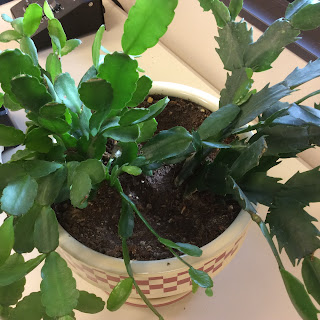Jane Rozum, Douglas County Extension
Last year around this time, I bought 3 small ‘Christmas Cacti’
that were $5 each at the grocery store. They were bright and colorful; just
what I needed during the ‘oh so short’ days of December. During the year, the
three cacti grew and last month (November), I started noticing flower buds and
blooms. But wait! They were supposed to bloom at Christmas!
I decided to do research on why they didn’t bloom at the
same time as last year. Well, come to find out that there is much to know about
this great holiday plant.
Holiday cacti hail from tropical rain forest areas in Brazil.
This group of ‘jungle cacti’ is in the Cactus family (Cactaceae) even though
they look nothing like our western US cacti. People have been growing these
plants for the holidays for at least the last 150 years. In fact, these
long-lived plants are considered heirlooms in many families and have been
passed down through generations.
There are three distinct
types of holiday cacti, which are distinguished by their bloom time and other
factors.
Botanical Name: Schlumbergera truncata cultivars
Characteristics: Bloom in late November, have stem
segments that have pointed teeth, asymmetrical flowers have bend at ovary, and
yellow anthers (pollen bearing end of filament inside flower).
Christmas Cacti:
 |
| Christmas Cactus stem segments |
 |
| Christmas Cactus bloom |
Botanical name: Schlumbergera x buckleyi
Characteristics: Bloom around Christmastime, have stem
segments that have rounded teeth, asymmetrical flowers do not bend at ovary,
and purplish anthers.
  |
| Easter Cactus bloom |
Botanical name: Rhipsalidopsis
gaerterni
Characteristics: Bloom in April, have stems segments with
rounded, scalloped edges and bristle-like hairs at the apex of the stem
segments. There flowers look more symmetrical and have golden yellow anthers.
 |
| Easter Cactus stem segments on left, Thanksgiving on right |
Seeing the holiday cacti together makes it easier to tell
the difference between the types. Thanksgiving cacti are the most common,
typically because florists can force the bloom time to correspond with
pre-Christmas sales.
Whatever type of holiday cacti you choose, care is relatively
easy. Water as needed; they do well when
the top inch of soil dries out between watering. More abundant blooms are
produced on plants that have a sunny location indoors. They are hardy enough to
go outdoors in the summer, but need a semi-shade environment and should be
brought indoors before the temperatures drop in the fall. All holiday cacti like
to be a bit pot-bound, so repotting every 3 years or so should be fine. Try
using a succulent potting mix when repotting, which is a bit courser and allows
more air movement through the soil. If you want to make your own potting mix,
use 60-80% potting media with 20-40% perlite. Fertilization is best done during
spring through late summer with a standard indoor fertilizer mix such as
15-30-15 with trace elements. Fertilization doesn’t encourage bloom, so doesn’t
need to be applied during the fall and winter months. Problems usually occur
when over or under watered, or from such pests as mealybugs, scale insects,
aphids and spidermites. Some cacti may drop unopened flower buds, which may
occur from a change in temperature, light or not enough water.
Coaxing a holiday cactus to bloom when desired will take
concentrated effort. Bloom time involves
either temperature or photoperiod regulation (the length of dark and light
during a 24 hour period). To get the plant to produce flower buds, the
following is needed:
·
Bright light during the day time such as an east
or south facing window.
·
Continuous darkness of 14 hours per day for six
weeks for complete bud set. This necessitates keeping plants in a darkened area
without household lighting. As little as 2 hours of inadvertent light during
this time can cause the plant to not set buds. Once there are buds on the
plant, the photoperiod times are not significant.
·
Nighttime temperatures between 50-59 degrees F
will encourage bud set regardless of photoperiod. Daytime temperatures, however,
are best kept between 60-68 degrees F for maximum flower production.
Enjoy your holiday cacti, whenever they bloom!




Holiday cacti are the one houseplant, other than snake plant and philodendron, that actually grow in my house! And I'm proud to report that one is in full bloom and the other is nearly there.
ReplyDeleteGreat blog, Janey!
I have what I believe is a Thanksgiving cactus - it matches the description and it bloomed in November - and it's blooming again now! All I can think is that our winter vacation created the right light conditions in our house for it to set buds again - no lights on in the evening, so longer dark periods.
ReplyDelete